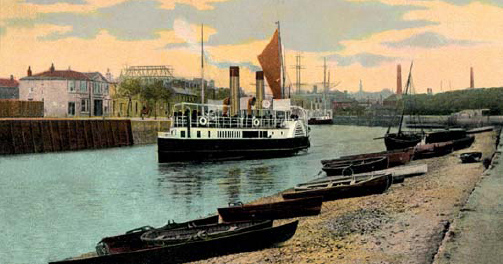

The paddle steamer Suffolk sets off from Ipswich to Lowestoft and Harwich. For many, this was the best part of their day at the seaside; for others, the service connected with coastal steamers to destinations and holiday resorts much further afield.
A trip on a pleasure steamer was one of the most popular aspects of the Victorian and Edwardian summer, and that popularity is epitomised in the competition amongst steamer owners. Competition became intense in some of the major resorts, with large owners trying every trick they could think of to squeeze single-ship owners out of business. On the south coast, the large steamer fleet operated by A.S. Campbell dominated. The pleasure steamers varied in size from tiny little vessels, which took perhaps no more than half a dozen visitors on short trips on the rivers, lakes and lochs of Britain, up to massive paddle steamers capable of carrying hundreds of passengers. These large ships often combined the role of pleasure steamer with that of working ferry.
From the world-famous ‘Wigan Pier’ on the Leeds–Liverpool Canal, daily cruises set off for a short excursion down the canal to the nearest lock gate and back. On the lakes and lochs, steamers – many of them owned by the big railway companies – connected with excursion trains and offered city dwellers a day out in a landscape about as far removed from their urban environment as could be imagined. On Loch Katrine in the Trossachs region of Scotland, a sail on the steamer Rob Roy and later on the Sir Walter Scott was an established part of many Victorian and Edwardian tours around the places associated with Scott’s life and works;Thomas Cook’s very first package tour of Scotland in 1843 included that as a highlight! The Sir Walter Scott, launched in 1900, still plies the loch in the summer season. Pleasure steamers also still serve several of the English Lakes.

The steamer Koh-i-Noor off Clacton, laden with more than enough passengers to give today’s health and safety officers a nightmare!

The steamer Rob Roy gets up steam in readiness for the first trip of the day up Loch Katrine from Trossachs Pier. Since the steamer service was introduced in the 1840s, only three vessels have operated the service – two called Rob Roy and the 1900-built Sir Walter Scott, which still serves the loch today.

At Trossachs Pier in 1903, a fleet of coaches is preparing for departure after picking up passengers from Sir Walter Scott, the stern and funnel of which can be seen in the distance. Their tour of Scotland would almost certainly have included a sail on Loch Lomond as well.

A photograph from the days when maximum permissible numbers of passengers were apparently of no concern to the steamer operators: if you could squeeze on board, you got on board! The heavily laden PS Royal Sovereign sets sail from London Bridge on her way to Clacton-on-Sea in 1905.

Another huge crowd aboard the PS Wemyss Castle as she prepares to leave the West Pier at Leith, c.1903. The 172-ton steamer had been built in Glasgow as the PS Gareloch in 1872, and she regularly sailed from Leith to North Berwick, and round the Fife coast.

The PS Ivanhoe passing Barton Bridge during a season as a pleasure cruiser on the Manchester Ship Canal in 1894, shortly after the canal opened. Built in 1880 for use on the Clyde, Ivanhoe had a working life of almost forty years. Her stay on the Ship Canal was not a financial success, and she returned to Clyde service in 1895. She was broken up in 1920.

Taking a leisurely walk along Bournemouth Pier was a popular form of recreation in the early years of the twentieth century. Posted as a Christmas card in 1905, this animated view was an ideal reminder of those simple summer pleasures. It was sent to a family in Bury St Edmunds from some friends they had met on holiday.